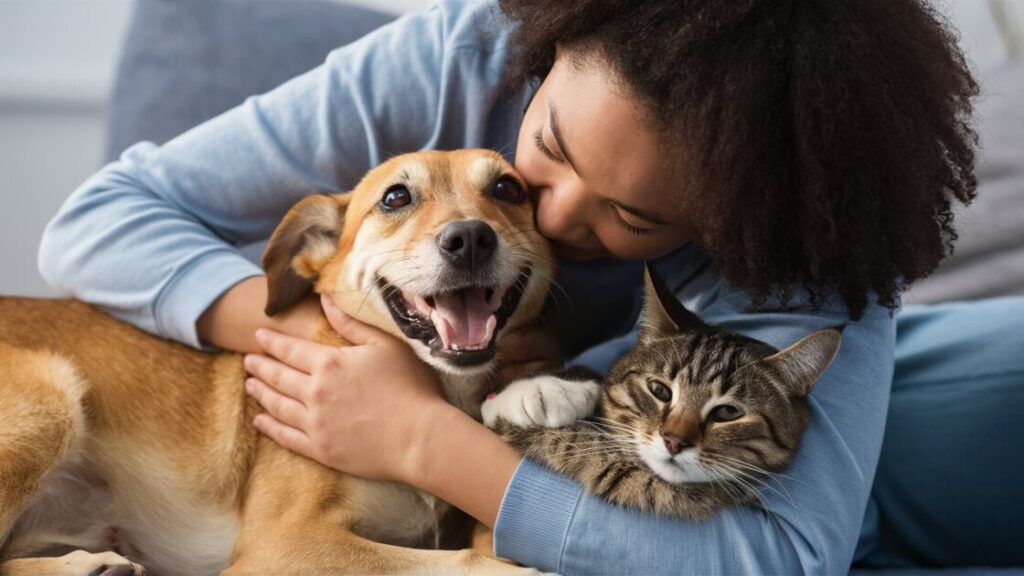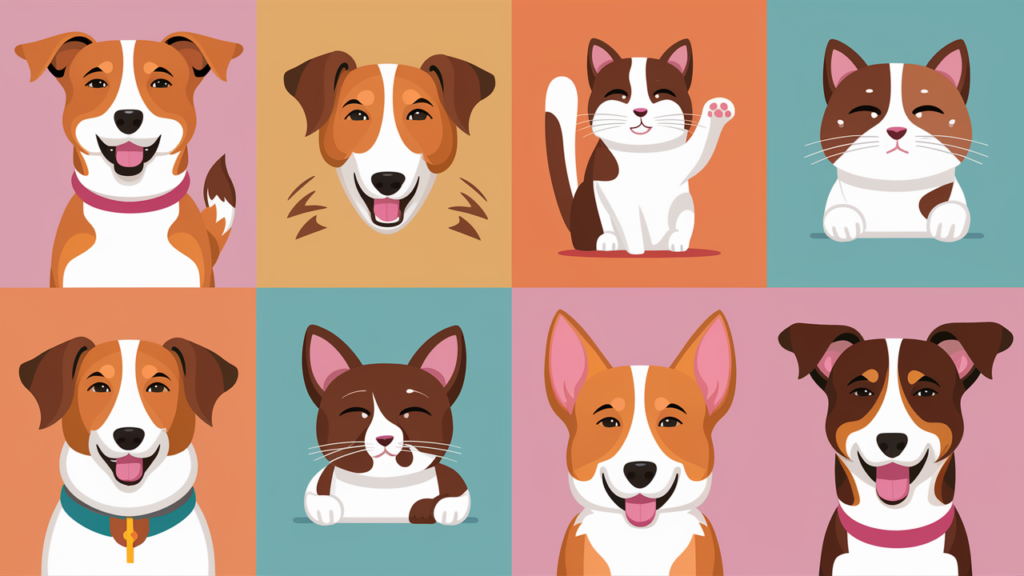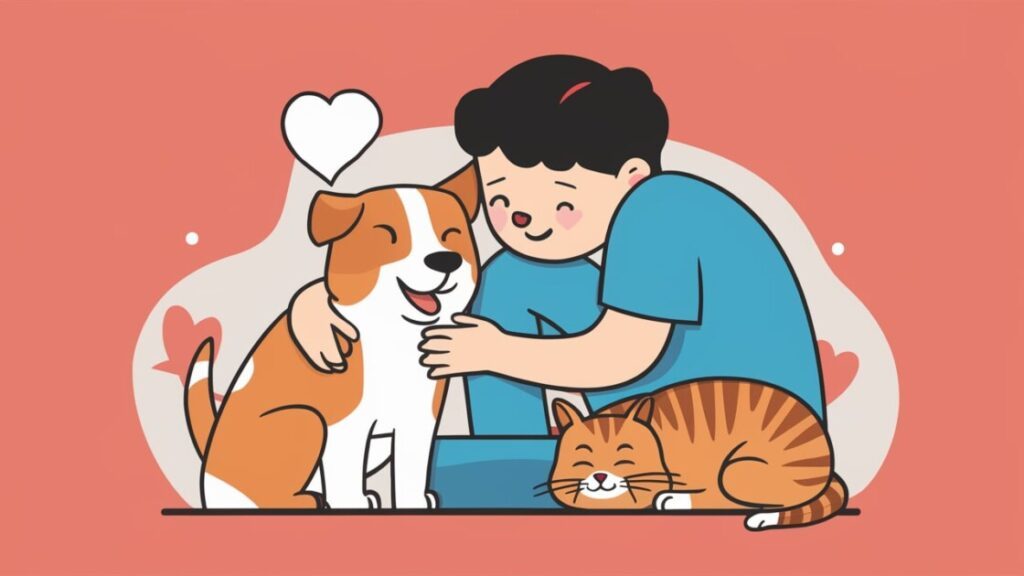Ever wished your furry friend could just tell you what they’re feeling? While they might not speak human, our beloved pets communicate volumes through their body language. From a swishing tail to flattened ears, every twitch and posture offers valuable clues into their emotions and needs.

As a fellow pet lover, I understand the frustration of wondering what’s going on in your pet’s mind. But fear not! This comprehensive guide will equip you to decipher your pet’s body language, fostering a deeper understanding and strengthening the bond you share.
Here, we’ll delve into the fascinating world of canine and feline communication, exploring their unique ways of expressing themselves:
Canine Conversations: Decoding Dog Body Language
Dogs are masters of nonverbal communication. By understanding their postures, facial expressions, and vocalizations, you can become a true dog whisperer!
The Tail Tells a Tale:
- High Wag: A wagging tail usually signifies happiness and excitement. The higher and faster the wag, the more enthusiastic your pup feels.
- Low Wag: A slow wag held low might indicate uncertainty, submission, or even fear.
- Stiff Tail: A raised and stiff tail can signal dominance or alertness, especially when accompanied by a tense posture.
- Tail Tucked Between Legs: This is a clear sign of fear or submission.
Wag More Than Just Tails:
- Playful Bow: A lowered front end with a wagging tail and perked ears is an invitation to play!
- Ears Back: Flattened ears can express fear, anxiety, or aggression.
- Whining & Whimpering: These vocalizations can indicate fear, anxiety, or submission, but also excitement in some situations.
- Growling: Growling is a warning sign, indicating your dog feels threatened or wants you to back off.
- Showing Teeth: This is a clear display of aggression and a warning to stay away.
Understanding the Canine Gaze:
- Soft Eye Contact: Relaxed eyes looking at you indicate trust and affection.
- Hard Stare: A direct and intense stare, especially with narrowed eyes, can signal dominance or aggression.
Remember: Dog body language is a complex system, and interpreting it accurately requires considering all the cues together.
Feline Finesse: Unraveling Cat Communication
Cats are often seen as mysterious creatures, but their body language reveals a rich tapestry of emotions. Here’s how to unlock their secrets:
The Tail Speaks Volumes:
- Upright Tail with a Twitch: This signifies a friendly and curious kitty.
- Puffed-Up Tail: A bushy tail held high can be a warning sign, indicating fear or aggression.
- Slow Tail Swishing: This might show annoyance or indecision.
- Tail Tucked Between Legs: Similar to dogs, this signifies fear or submission.
The Power of the Postures:
- Rubbing Against You: This is a clear sign of affection and a request for attention.
- Lying on Their Back: An exposed belly isn’t just for naps! It’s a display of ultimate trust and comfort with you.
- Arched Back: A curved back with flattened fur can indicate fear or aggression.
- Hissing: An unmistakable sign of displeasure, a hiss is a warning to leave them alone.
Understanding the Feline Gaze:
- Slow Blinking: Often called a “cat kiss,” this slow blinking expresses affection and trust.
- Wide Eyes & Dilated Pupils: This could indicate fear, surprise, or even excitement in some situations.
- Staring: A prolonged stare, especially with narrowed eyes, can show dominance or aggression.
Remember: Cats are more subtle than dogs in their communication. Pay attention to even minor changes in their posture, tail movement, and facial expressions.
Beyond the Basics: Building a Vocabulary of Body Language Cues
Now that you have the fundamentals, let’s explore some additional body language cues to further enhance your understanding:

- Hacking and Coughing: These sounds can indicate kennel cough in dogs or hairball issues in cats.
- Yawning: While often a sign of tiredness, yawning can also be a way for pets to express stress or anxiety.
- Panting: Panting can be normal after exercise or on hot days, but excessive panting can indicate overheating or anxiety.
- Licking: Licking can be a sign of affection, nervousness, or a way to soothe themselves.
Building a Stronger Bond: Putting Your Pet Body Language Knowledge into Action
By understanding your pet’s body language, you can build a stronger and more fulfilling relationship. Here’s how to put your newfound knowledge into action:
- Respond Appropriately:
- If your dog shows signs of fear during a walk, find a quieter route or head home.
- If your cat seems stressed during playtime, offer them a quiet space to relax.
- Recognizing your pet’s discomfort allows you to adjust your behavior and create a more positive environment.
- Respect Boundaries:
- Learn to recognize subtle signs of discomfort, like flattened ears or averted gazes. Don’t force interaction if your pet feels overwhelmed.
- Enhanced Training:
- Body language awareness helps interpret your pet’s responses during training sessions. A wagging tail tells you they’re engaged, while a tucked tail suggests needing a break.
- Early Detection of Issues:
- Changes in your pet’s body language can be a red flag for underlying health problems. Observe any persistent changes and consult your veterinarian if needed.
- Strengthen Communication:
- Respond to your pet’s positive body language with affection and praise. This reinforces desired behaviors and fosters a deeper bond.
Tailoring Your Approach: Recognizing Breed Variations
It’s important to remember that some breeds have naturally higher energy levels, influencing their body language. A Husky’s enthusiastic tail wag might not signify the same level of excitement as a Chihuahua’s.
Similarly, certain breeds like Bulldogs have naturally flat faces, making it harder to read subtle facial expressions. Research your specific breed and learn their typical body language characteristics.
Beyond Body Language: A Holistic Approach
While body language is crucial, it’s just one piece of the puzzle. Consider these additional factors for a comprehensive understanding of your pet:

- Vocalizations: Pay attention to your pet’s barks, meows, purrs, and other vocalizations.
- Routine & Environment: Changes in their usual environment or daily routine can impact their behavior.
- Health Considerations: Underlying medical issues can sometimes manifest through changes in body language.
Conclusion: Unlocking the Language of Love
By learning to “speak” your pet’s unique language, you’ll unlock a deeper connection that enriches both your lives. From recognizing their needs to responding to their emotions, understanding body language strengthens the bond you share.
So, the next time your furry friend wags their tail, flicks an ear or lets out a purr, remember it’s not just random behavior. It’s a conversation waiting to be deciphered!
Embrace the world of pet body language, become a true pet whisperer, and watch the love and understanding between you and your furry companion blossom!
FAQ: Decoding Your Pet’s Secret Language – A Guide to Dog & Cat Body Language
Here are some frequently asked questions about deciphering dog and cat body language:
1. My pet’s body language seems confusing. What should I do?
Don’t worry! Body language is a complex system, and interpreting it accurately requires considering all the cues together. Focus on learning the basics like tail positions, facial expressions, and postures. Observe your pet in different situations to understand their typical behavior.
2. Is there a difference in body language between dog breeds?
Absolutely! Some breeds naturally have higher energy levels, influencing their expressions. Research your specific breed to learn their unique body language characteristics.
3. My pet’s body language seems different lately. Could it be a health issue?
Changes in your pet’s body language can sometimes be a red flag for underlying health problems. If you notice persistent changes in their usual behavior, consult your veterinarian for a check-up.
4. How can I use body language to improve my pet training?
Understanding your pet’s body language helps you interpret their responses during training sessions. A wagging tail tells you they’re engaged, while a tucked tail suggests needing a break. Adjust your training approach based on their body language cues.
5. What are some additional tips for strengthening my bond with my pet?
Respond to positive body language with affection and praise.
Respect your pet’s boundaries and avoid forcing interaction if they seem uncomfortable.
Pay attention to their vocalizations and their overall environment, as these can also influence their behavior.
6. Are there any resources for learning more about pet body language?
Yes! Here are a few suggestions:
The American Kennel Club (AKC): Dog Body Language
The Spruce Pets: Cat Body Language Guide
The Association of Professional Dog Trainers: Understanding Dog Body Language
By understanding your pet’s body language, you can build a stronger and more fulfilling relationship. Happy decoding!